Magna Britannia: Volume 5, Derbyshire. Originally published by T Cadell and W Davies, London, 1817.
This free content was digitised by double rekeying. Public Domain.
Daniel Lysons, Samuel Lysons, 'Antiquities: Ecclesiastical', in Magna Britannia: Volume 5, Derbyshire(London, 1817), British History Online https://prod.british-history.ac.uk/magna-britannia/vol5/ccxix-ccxxxvi [accessed 23 April 2025].
Daniel Lysons, Samuel Lysons, 'Antiquities: Ecclesiastical', in Magna Britannia: Volume 5, Derbyshire(London, 1817), British History Online, accessed April 23, 2025, https://prod.british-history.ac.uk/magna-britannia/vol5/ccxix-ccxxxvi.
Daniel Lysons, Samuel Lysons. "Antiquities: Ecclesiastical". Magna Britannia: Volume 5, Derbyshire. (London, 1817), British History Online. Web. 23 April 2025. https://prod.british-history.ac.uk/magna-britannia/vol5/ccxix-ccxxxvi.
In this section
Ancient Church Architecture.
Saxon.— Of the ecclesiastical edifices of Derbyshire, the crypt under the parish church of Repton claims the first notice; there being good reason to suppose, that it was a part of the conventual church, destroyed by the Danes, who wintered here at this place in the year 874; at which time Edburga, daughter of Adulph, King of the East-Angles, was abbess of Repton. There have been three entrances to this crypt by flights of steps, one on the north side, now open; and two on the west, which appear to have communicated with the church. It is nearly a square of seventeen feet, the roof being vaulted with circular arches, supported by four columns of less massy proportions than those of the later Saxon architecture, the capitals are very plain and square, the bases round, without any mouldings: the shafts are wreathed in different directions.
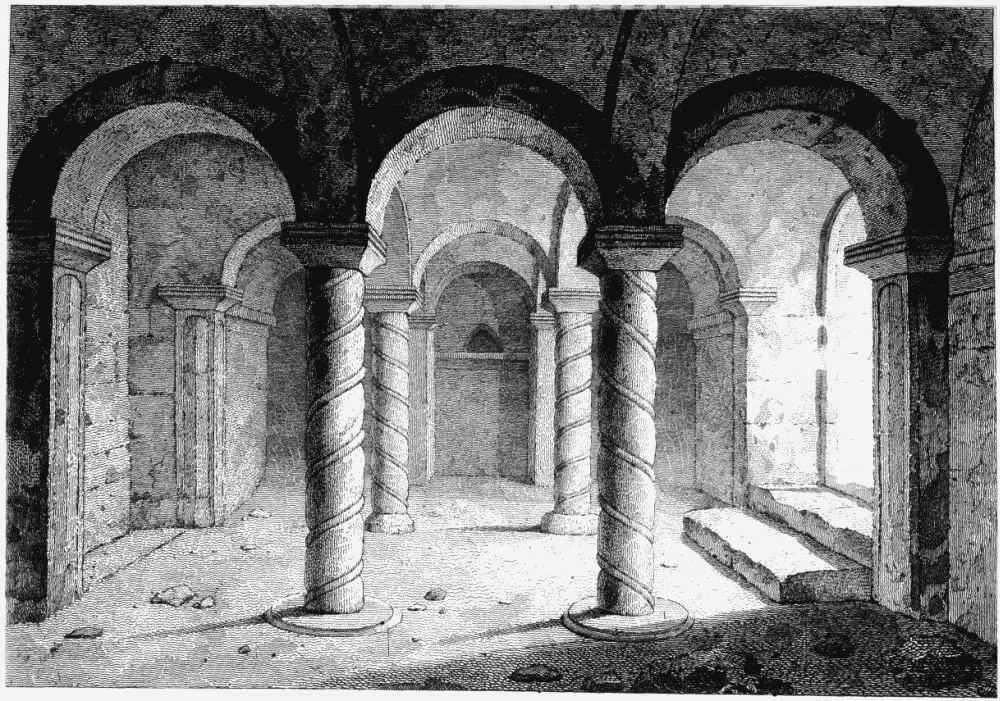
Crypt under the chancel of Repton church
Melbourne church is a very perfect specimen of the massy style of architecture which prevailed in the eleventh century; a plan and sections of this church were published by the Society of Antiquaries, in the thirteenth volume of the Archaeologia, from drawings by the late William Wilkins, Esq., who conjectured that it was erected by King Ethelred, in the seventh century. We cannot but think that he has referred this edifice to too early a period, as its style by no means accords with that of the buildings, which, on the best evidence, are supposed to have been erected in the Saxon times; of which the conventual church at Ely, and the crypt at Repton, are those, whose dates are, perhaps, the best authenticated; but it coincides with that of the ecclesiastical edifices, which we know to have been built about the time of the Norman conquest.

Elevation of part of the nave of Melbourne church
Melbourne church has undergone little alteration, except in the lower range of windows, which have been enlarged; it consists of a nave and side aisles, separated by massy pillars, some of the capitals of which are ornamented with foliage and figures of animals, others with crosses: the arches are circular, ornamented with zig-zag mouldings. Between the nave and chancel is a large square tower, the upper part of which is more modern, with pointed windows; at the east end of each aisle is a chantry. The east end of the chancel and that of each of the chantries, Mr. Wilkins observes, appear to have been originally circular; they are now all square, with Gothic windows. The entrance at the west end of the church consists of three porticos, with groined. roofs, divided by arches from the nave, having chambers over them: Mr. Wilkins supposes these to be theporticus of the Saxon churches, described by Bede.The whole length of Melbourne church, within the walls, is 133 feet, the width 44 feet 9 inches. A specimen of the architecture of the nave is shewn in the annexed plate.
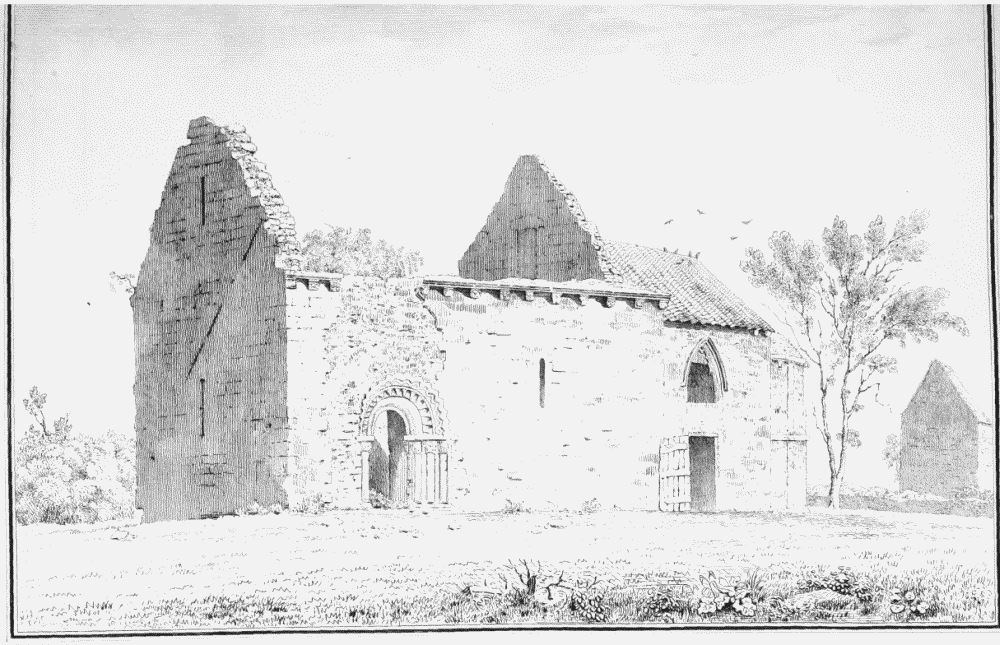
South-west view of Steetley church
The desecrated church of Steetley exhibits a very complete specimen of the later and more enriched style of Saxon architecture, on a small scale. It is quite entire except the roof, and has undergone no alteration except in one of the windows on the south side, which has been enlarged. It consists of a nave and chancel, each 26 feet in length; the east end being cir cular and vaulted: the ribs of the arches, and the capitals of the half pillars, from which they spring, are much enriched with various mouldings, grotesque heads, foliage, and other ornaments. A cornice, supported by brackets, ornamented with roses, heads, &c. runs round the upper part of the building on the outside. The circular part at the east end, has also a fascia of foliage running round it, about the middle of the building; and is besides enriched with pilasters in the Saxon style. The arch of the south door-way is ornamented with zig-zag mouldings and heads; the shafts of the pillars are covered with sculptured foliage and other ornaments, in the style of the south door-way of Ely cathedral.
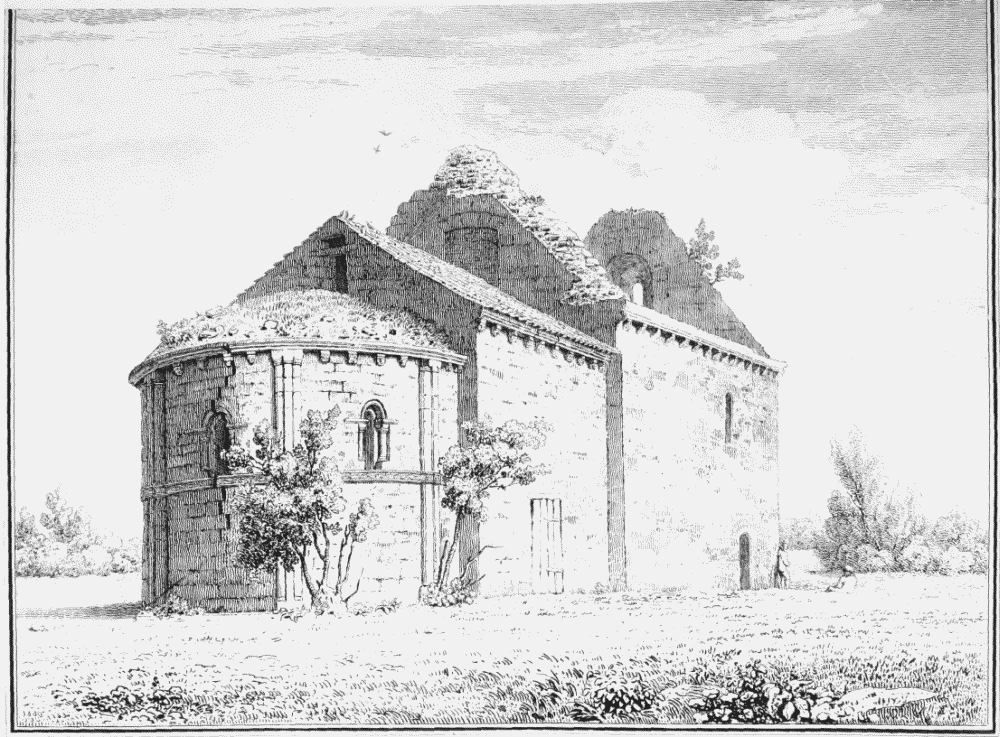
North-east view of Steetley church
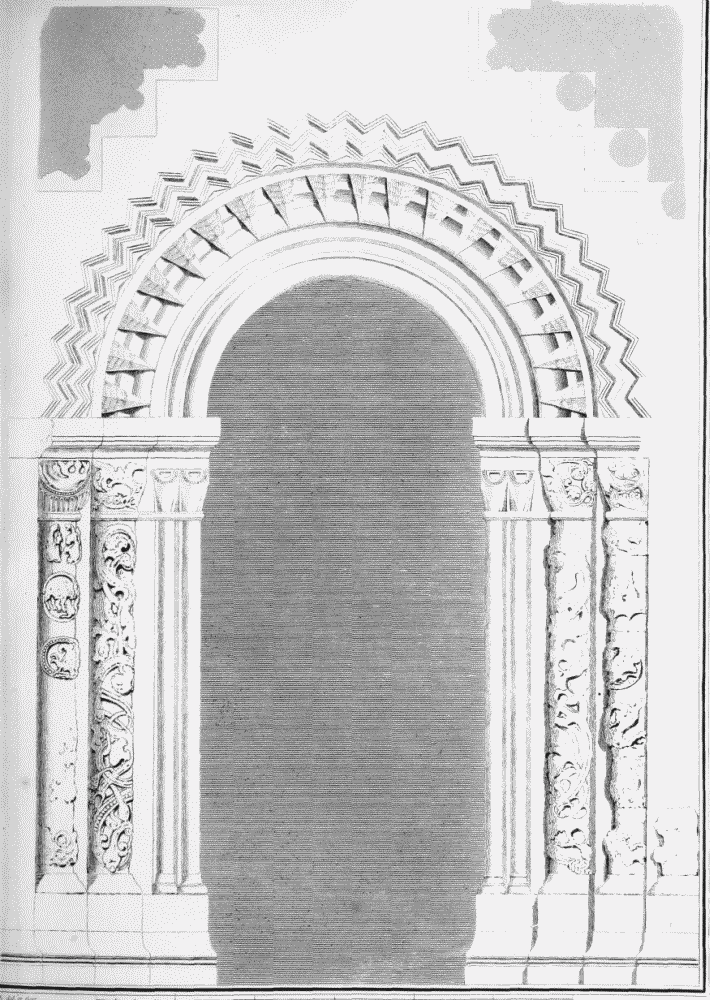
South doorway of Steetley church
Considerable remains of Saxon architecture are to be seen in the churches of Alsop-in-the-Dale, Ashford, Bradburn, Bakewell, Bolsover, Boulton, Brailsford, Brassington, Clown, Darley, Heath, Halt-Hucknall (fn. n1),Hog naston, Keddleston, Killamarsh, Kirk-Ireton, Ockbrook, Parwich, Sandiacre, Stanton, Swarkston, Tissington, Thorp, Whitwell, Longford, Willington, Winster, and Youlgrave. The south door-ways of those of Ashford, Hognaston, Keddleston, and Swarkston have rude sculptures in bas-relief within the circular arch: of Bradburn and Whitwell churches, the towers at the west-end are in this style of architecture. At the west-end of Bakewell church is a large arch, very richly ornamented with Saxon mouldings and grotesque heads: on the sides of this arcb are some remains of small interlaced arches.
Thirteenth Century.— The specimens of the early Gothic architecture which occur in Derbyshire are few, and by no means remarkable. The chancels of Bakewell, Marston-upon-Dove, and Doveridge churches are in this style, as is Breadsall Church, which is a handsome edifice, with an embattled tower, supporting a spire at the west end. In the ruins of Stid Chapel are clustered pillars with foliated capitals, and the windows which remain are lancet-shaped.
Fourteenth Century.— Tideswell church is a large uniform building, in the form of a cross: the nave and aisles are separated by clustered pillars and pointed arches. At the west end is a tower, with four embattled turrets, terminating in pinnacles, ornamented with crockets. The altar-piece is of stone, enriched with two tabernacles; and on each side of the east window, over the altar, is an ornamented niche. John Foljambe, who died in 1358, and whose monument is in Tideswell church, is said to have been a principal contributor to the erection of that, edifice. The chancels of Norbury, Dronfield, and Sandiacre churches exhibit fine specimens of this style. That of Norbury church has large handsome windows, with much of the original painted glass remaining in them.
Remains of the architecture of this century are to be seen in the churches of Mackworth and Marston-upon-Dove: there is a very elegant window, with a niche on each side, at the east end of the north aisle of Mackworth church; and in the north wall of the same aisle is an arch, with a richly ornamented canopy over it, between two windows. Spondon church is a handsome building in the style of this century.
Fifteenth and Sixteenth Centuries.— There are no remains of the eccle siastical architecture of these centuries worthy of particular notice, except the tower of All-Saints' church at Derby, which has been generally and deservedly admired: it is about 150 feet in height, and richly ornamented with Gothic tracing; that of the battlements being pierced. (fn. n2) On a fascia, running round three sides of the tower, is this inscription, in text hand — " Young men and maydens."
Painted Glass.—There are some remains of painted glass in the churches of Ashborne, Bradley, Dronfield, Egginton, Halt-Hucknall, Sandiacre, and Sutton; but none of sufficient consequence to merit particular notice. In the churches of Morley and Norbury, the remains are considerable: those in the chancel of the latter, are in a very good taste; and evidently coeval with the building, which is in the style of the fourteenth century. Specimens, selected from different windows, are shown in the annexed plate.
In the north aisle of Morley church are four windows, occupying nearly the whole of the north side, filled with painted glass, said to have been brought from Dale-Abbey, at the time of the dissolution; and consisting of various legendary subjects, in small compartments, with inscriptions in text-hand. Both the figures and inscriptions are a good deal mutilated; but the subject of several of them, which appear to have belonged to a connected series, may still be made out. They relate to a tradition that, on a dispute between the canons at Depedale and the keepers of the forest, the King granted to the canons as much land as, betwixt two suns, could be encircled with a plough drawn by stags, which were to be caught from the forest. Under one of the compartments is this inscription — " Go whom and yowke them, and take ye ground ttye plooe;" and under another — " Here Saynt Robert plooyth wyth the. ...." In the east window is a figure of St. Ursula, crowned, and surrounded with glory; and beneath her, two angels, holding the virgins in a cloth; with this in scription on a label —"Sea Ursula, cum xi mill, virginum, ascendens in caelwn"
Rood-lofts, Screens, and Stone Stalls. — In Ashborne church is a very perfect rood-loft and screen, and at Ilkeston a stone screen of the rood-loft, in the style of the thirteenth century. In Chelmorton church is a stone screen, with quatrefoils at the top; and the lower part of one in Bakewell church. In Elvaston church is an elegant Gothic screen of the rood-loft; and in the chapel at Hayfield an entire rood-loft, the upper part of which is modernized, and has a modern painting of the crucifixion, and St. Mary, and St. John.
In each of the churches of Brailsford, Breadsall, Church-Broughton, Dronfield, Ilkeston, Langley, Longford, Sandiacre, and Spondon, are three stone stalls, of equal height. Those of Dronfield and Sandiacre are richly ornamented, in the style of the fourteenth century, and there is a piscina adjoining each, in the same style. (fn. n3) In Baslow, Denby, and Whitwell churches are two stone stalls: those at Whitwell are richly ornamented in the style of the fourteenth century. In the chancel of Chaddesden church is a single stone stall, with a piscina; and a single one also in the north, and another in the south aisle of the same church.
Ancient Fonts. — There are few of the Derbyshire fonts that are worthy of notice, except that in Ashover church, which is of lead, and apparently -very -ancient, being in the Saxon style: it is two feet one inch in width, and one foot in height; and is placed on a stone pedestal of more modern ;Stote, This font is ornamented with twenty figures of men, in flowing drapery; each holding a book in his left hand; and differing only in the position of the head, and of the right hand, which is more or less elevated in different figures: they are all very rudely executed in bas-relief, and stand under circular arches, separated by slender pillars. The fonts in kirk-Hallam and Osmaston churches are circular: the former being ornamonted with tracery of semicircular interlaced arches; the latter with tracery of circular arches and foliage. Those in Winster and Mellor Churches are large and circular, ornamented with rude sculptures in basrelief. Melbourne font is in the form of a basin, standing on four legs (fn. n4); that in Bakewell church is large, and in the Gothic style, ornamented with figures, very rudely executed, in bas-relief.
Ancient Sepulchral Monuments.— The most ancient sepulchral monument which occurs in this county, is one recently discovered on the west side of Repton church yard, a figure of which is annexed. It much resembles in form, and the style of its rude ornaments, the two stones in penrith church-yard in Cumberland, forming part of the ancient monument called the "Giant's grave;" and is no doubt to be referred to the period when the Saxon monastery existed at Repton.
Of the ancient gravestones, without inscriptions, having crosses-florée, &c. engraved on them, many are to be seen in the Derbyshire churches; in the porch of Darley church is one with a rich cross-florée, bugle horn, and sword (fn. n5); in the chancel of Stavely church, one with the cross-floree, and sword: another of the same kind over a window in the north aisle of parwich church; in the chancel of Chellaston church, one with a cross-floree and a chalice.
'Thirteenth and Fourteenth Centuries. — In the south transept of Darley church is the effigies of a crusader, with curled hair and beard, carved in Stone, holding a heart in his hand; at his feet is a large rose. In the middle of the chancel of Ilkeston church, is an altar-tomb with the effigies of a crusader, in stone, whose shield is charged with a fesse, Vaire, between three leopards' heads jessant des lys, reversed. In Melbourne church, under an obtuse arch in the south wall of the south aisle, is the mutilated effigies of a crusader, in mail and surcoat, with a bandeau of jewels round his head; on his shield are the arms of Melbourne, a chevron between three escallop shells. Under an ogee arch on the outside of the chancel of the same church, against the south wall, is the effigies of a crusader in stone, in mail and surcoat, with a large angular shield, and a lion at his feet. In the chancel of Norbury church is the effigies of a crusader, in the act of drawing his sword.
On the floor of the chancel in Keddleston church, on removing two circular pieces of wood, about a foot below the surface, appear the head of a knight in mail armour, and that of his lady in veil and wimple; sculptured in pretty high relief; part of their hands also appear joined in the attitude of praying: each of these sculptures is inclosed within a quatre-foil. In the year 1810, the stones above being removed, it appeared that these quatrefoils, and the heads within them, were cut on a large gravestone, four feet wide and ten inches thick, without any inscription.
In the nave of Brampton church is a very curious sepulchral monument, apparently of the thirteenth century, which was discovered more than a century ago, on digging a grave (fn. n6), and is now placed upright against the wall of the nave. Within a quatrefoil at one end of the stone, is the upper part of a female figure, holding a heart in her hand (fn. n7), scrulptured in bas-relief; at the other and her feet and the lower part of her drapery appear, as through an oblong opening. (fn. n8) On one side of the quatrefoil, is a cross-floree. On the flat part of the stone this inscription appears, cut in very fair Lombardic capitals," Hic jacet Matilda le Caus, orate pro anima ej' pat' nost' (fn. n9) " Though the inscription is perfect, it is uncertain for whom this monument was designed: it seems probable, however, that it was a person of no less consequence, than Matilda the heiress of the barony of Cauz, who died in the eighth year of King Henry III.; as there is reason to suppose, that Peter de Brampton, who then held the manor of Brampton, was her son; his grandson having assumed the name of De Caus. As the head-dress represented on this monument does not appear to be of so early a period as the beginning of the reign of King Henry III., it is not improbable that it might have been inscribed to her memory, several years after her death, by her son, or one of his descendants.
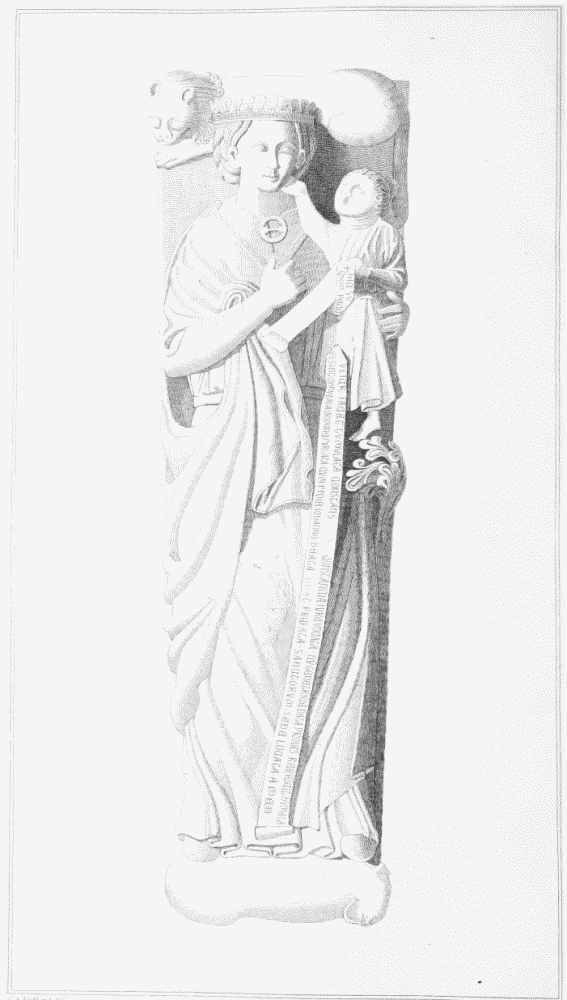
Ancient monument in Scarcliffe church
In Scarcliffe church is a monument representing the effigies of a lady, in a long gown and mantle, with a rich coronet on her head, holding a child in her left arm, with a lion for her pillow, and some other animal at her feet. On a long scroll, held by the child, is the following inscription in Leonine verses, engraved in Lombardic capitals (fn. n10) :
"Hic su[b humo strata m]ulier jacet tumulala
Constans et grata, Constancia jure-vocata,
Cū genetrice data proles requiescit humata.
Quanquam pecc[ata capiti ej]us sint cumulata,
Crimine purgala cum prole Johanne beata
Vivat, prefata sanctorum sede locata. Amen."
It is most probable that this lady was one of the baronial family of Frecheville, which possessed the manor of Scarcliffe for several generations, till it was forfeited to the crown in 1275, by Adam de Frecheville, who had joined the rebellious barons.
At Repton is a gravestone, found in the year 1749, in the ruins of the monastery, with an imperfect" inscription round the edge in Lombardic capitals, in Leonine verses, the first of which Dr. Pegge reads thus (fn. n11), "Radulphum gratum lapis iste tegit humatum."
In Croxall church, among several alabaster gravestones, with engraved effigies of the Curzon family, is one of John Curzon, Esq., and his wife, A.D. 1350. He is represented in plate-armour, with a pointed helmet. In the chancel of Elmton church is a gravestone, with a cross-florée engraved on it, and this inscription in text-hand, " Orate pro aiā Rob'ti Berbi..."
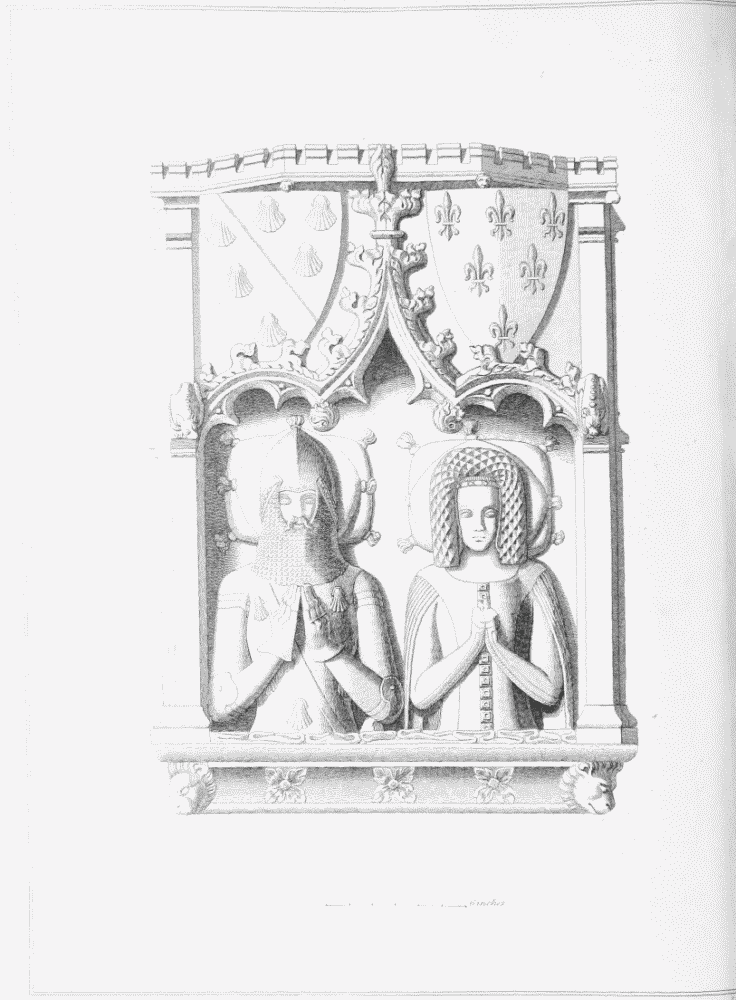
Monument of Sir Godfrey Foljambe and his Lady in Bakewell church
In Bakewell church, against an arch on the south side of the nave, is the monument of Sir Godfrey Foljambe, who died in 1376, and his lady (Avena), who died in 1383, with half-length figures, smaller than life, carved in ala baster in alto-relievo, under a canopy: he is represented in a pointed helmet, and plate-armour; over his head is a shield, with the arms of Foljambe, a bend between six escallop-shells; and over the lady a shield of arms, being semee of fleurs-de-lis. In the vestry, within the south transept of the same church is a monument, with the effigies, in alabaster, of a knight in plate-armour, mail gorget, and pointed helmet, with a richly-ornamented bandeau, his pillow being supported by angels: this is supposed to be the monument of Sir Thomas Wendesley, or Wensley, who was mortally wounded at the battle of Shrewsbury. (fn. n12)
In the north transept of Ashborne churcb, is a large embattled altar-tomb, enriched on the sides with quatrefoils and shields of arms. On the top are two effigies in alabaster; the one of a knight in plate-armour, with pointed helmet, having his arms, three cocks, expressed on his breast, a lion at his feet, and angels supporting his pillow: the other of an old man in a close cap, with a short beard, habited in a tunic, with a robe falling over his left shoulder; a purse and a dagger attached to his girdle, and a dog at his feet. This monument was evidently intended for some of the Cokaine family; and it is probable that the effigies in armour is that of John Cokaine, Esq., who was some time knight of the shire, and died in 1373. In the same transept is another altar-tomb of alabaster, with the effi gies of a knight of the same family, and his lady; the sides are much en riched with Gothic tracery, and figures of angels holding shields of arms. The knight is in plate-armour, with a collar of S.S.; under his head is a helmet, with his crest (a cock's head) and lamberquin. The lady is dressed in a close gown and mantle, with the reticulated head-dress.
In the chancel of Dronfield church is a gravestone, with the effigies of two priests engraved on brass plates; they are habited in copes, the borders of which are ornamented with quatrefoils: between them is the figure of a bugle-horn, and under them these inscriptions in text-hand: —" Hic jacet Dnus Thomas Gomfrey de Wormhull quod'. Rector ecclie de Dronfield qui obiit iio die mensis Octob'. anno Domini M.CCC.lxxxx nono." — "Hic jacet Dns Ricus Gomfrey quoda Rector eccl'ie de I denhall et P'bendari' de Somer-shall in Capella Regis de Penkcriche et frat' D'ct Thome qui obiit ano Dom'i Millo CCC.... quorum animarum, &c"
In Longford church are several ancient monuments of the Longford family, who possessed the manor for more than three centuries. One of these is an altar-tomb, under a richly-ornamented arch, at the east end of the south aisle; on which lies the effigies of a knight, in plate-armour, mail gorget, and pointed helmet, with a collar of S.S., his hands being joined in the attitude of prayer: under his head is a large helmet with the crest of Longford, which here much resembles three mushrooms. (fn. n13) Near this monument is another effigies of a knight, in plate-armour and mail gorget, with the arms of Longford on his breast, carved in alabaster. At the end of the north aisle, in the same church, is an altar-tomb, enriched with shields of the arms of Longford, &c.; on it lies the effigies of a knight in plate-armour, with a richly-ornamented helmet, surrounded with a bandeau, on the front of which is inscribed, in text-hand," Ihc."
In the church of Newton-Solney are two ancient monuments of the Solney family: one of them, being the effigies of a knight in mail and surcoat, his feet resting on two foliated brackets, with his left hand on his breast, his right hand on his sword, carved in stone, has been removed from the nave, into a lumber-room on the north side of the chancel. The other is under an arch in the north wall of the chancel, being the effigies of a knight in plate-armour, with mail gorget, carved in alabaster, with angels supporting his pillow, and a lion at his feet.
Against the east wall of the chancel of Barlborough church, is a slab of alabaster, with the effigies of a lady carved in bas-relief; she appears habited in a close-bodied gown and mantle, with a veil. At her feet is a shield of arms, and one on each side of her head: that at the dexter corner of the stone is charged with a saltire; that at the sinister corner, with a bend between six martlets. The inscription is now nearly effaced; about a century ago, the following words appear, from Bassano's Church Notes, to have been legible," Hic jacet.... Johanne fil. ... her. ... Willielml Four-nival.. ..;" from which it appears to have been the monument of Joan, wife of Sir Thomas Nevil, Knight (fn. n14), who in her right became Lord Furnival: she died about the year 1399.
On the north side of the nave in Cubley church, is an altar-tomb of alabaster, enriched with figures of angels holding shields. On the top is the effigies of a knight in plate armour, with a rich bandeau round his helmet: on his forehead are the letters " Ihc," in text-hand, and under his head a large helmet. This no doubt was intended for one of the Montgomery family, which possessed the manor of Cubley from the twelfth to the sixteenth century.
Under a richly-ornamented arch, on the north side of the chancel of Shirland church, lies the mutilated effigies of a knight in plate-armour, richly ornamented with scrolls of foliage. The side of the monument is covered with shields of arms; among which are several of the family of Grey of Shirland, ancestors of the Lords Grey de Wilton, who possessed the manor of Shirland for several generations. It is probable that this was the monument of Sir Henry Grey, who died 19 Ric. II.
Fifteenth Century. — In Chellaston church is a gravestone, with a cross floree, and the date of 1405.
On a step of the altar in Morley church is the following inscription, in text-hand, on a brass plate: — " Orati p' ai'abus Godithe de Stathum, d'ne de Morley, et Ricardi filii sui, qui capanile istud et eccl'iam fieri fecert...... quibus tenent' anno d'ni Milli'mo CCCC. tercio"
In Mugginton church, under an arch between the chancel and the north aisle, is an altar-tomb, with brass plates on the sides, representing angels holding shields of arms. On the slab, which is of Purbeck marble, is the effigies of a knight, in plate-armour and collar of S. S., bare-headed, with a very long sword; having a helmet under his head, with his crest (a fox), and lamberquin; and that of his lady habited in a long gown and mantle, with flowing hair and a bandeau of roses, with figures of five sons and one daughter, beneath them, all engraved on brass plates. The inscription is now nearly gone; in Bassano's Church Notes, taken about a century ago, the following is given as then remaining: — "...... Richus Knyveton drs de Mercaston et Underwood, et Johanna uxor ejus, qui quidem Richus obiit.... die. .... A. Domini MCCCC. quor' &c."
At the east end of the south aisle of Dronfield church is an altar-tomb of alabaster enriched with figures of angels holding shields. Upon it lies the effigies of a knight in plate-armour, without a helmet,. in the style of the fifteenth century.
On the north side of the chancel of Hathersage church is an altar-tomb, with brass plates, on which are engraved the effigies of a man in plate-armour, with a long sword, and of his lady in a veiled head-dress; and figures of eleven sons and three daughters, with their Christian names. Under the effigies is the following inscription: — " Hic jacet Robertus Eyre armiger qui obiit xxi die mensis Marcii anno Millimo CCCColix, et John a uxor ejus qui obiit ixo die mensis Marcii ao dni Millimo CCCC.lxiii ac pueri eorudem quor' &c."
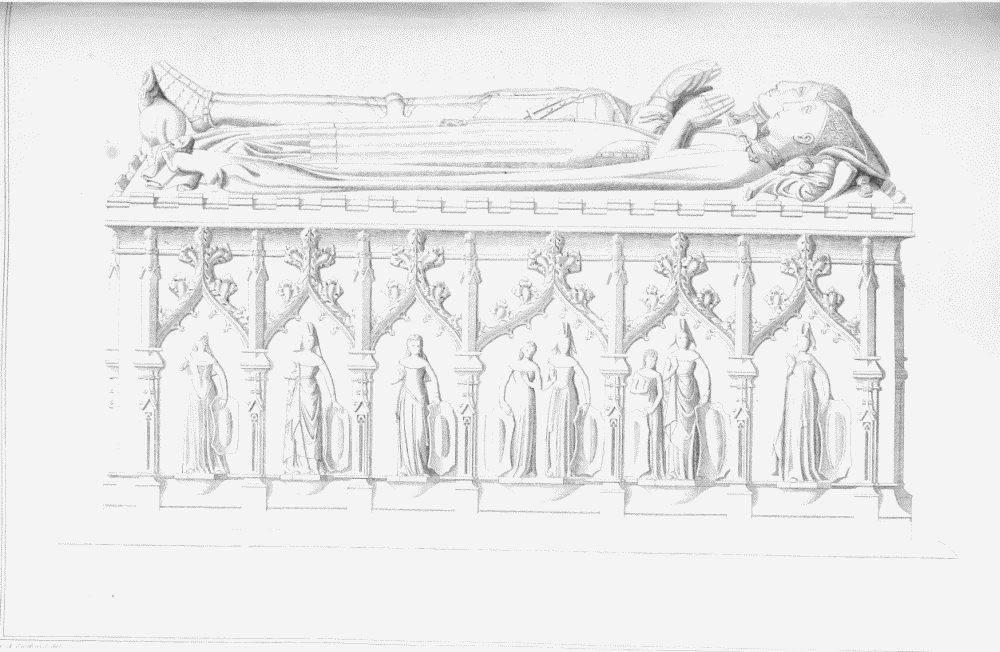
Monument of a Knight of the Fitzherbert family and his Lady, Norbury church
Under the arch, between the nave and north transept of Norbury church, is a rich altar tomb of alabaster, enriched with elegant Gothic tracery, and figures in bas-relief, of ladies holding shields. On the top are the effigies of a knight and his lady; he appears bare headed, in plate armour, with a lion at his feet; the lady, in the veiled and reticulated head dress, with angels supporting her pillow, and two little dogs at her feet. (fn. n15) Under the arch of the south transept in the same church, is an altar-tomb of alabaster the sides of which are much enriched with figures in bas-relief. On it lies the effigies of a knight, in richly ornamented plate armour, bare-headed; with a collar of roses and a lion at his feet. These two monuments are of the Fitzherbert family, which has possessed the manor of Norbury for several centuries.
On an altar tomb on the north side of the chancel in Swarkston church, is a gravestone of alabaster, with the engraved effigies of a man in plate armour, with a greyhound at his feet; and of his lady, with a dog under each foot, and figures of seven sons and as many daughters: round the verge of the stone is the following inscription: — "John Roliston, Esquier, sutyme Lord of Swarston, dysseysyd the iij day of Deceber in ye zere of our Lord the MCCCClxxxij; and Susane his wife, dysseysyd the 23d of December, ye yeare of our Lord MCCCClx & v, on whose soules God have mercy."
On the north side of the chancel in West-Hallam Church is an altar-tomb, with the effigies of a man in plate armour, having a shield of arms on each side of his head (a fesse between three cinquefoils, impaling a spread eagle), with this inscription: — " Hic jacet Tomas Powtrell, armig' quondam dns istius ville ac patron' istius ecclle' qui obiit xxiiij die Augusti Ao dni Mo.CCCColxxxiiij, cuj', &c."
In Hathersage church is a wooden tablet hanging upon the north wall, with brass plates gilt, containing the effigies of a man in armour, bare headed, and his lady, with this inscription:—"Orate pro animabus venerabilis viri magistri Radulphi Eyre quondam de Offerton in Com. Derbi generosi etElisab. uxoris ejus, qui quidem Radulphus obiit a no Dom. 1493.
In the chancel of Bakewell church is an altar-tomb of alabaster, enriched with figures in bas-relief in niches; round the slab on the top is this inscription: — " Hic jacet Johes Vernon filius et heres Henrici Vernon qui obiit xii die mensis Augusti Ao dni MmoCCCC' lxxvii, cuj.' &c."
In Doveridge church is an alabaster gravestone, with the engraved effigies of Ralph Okeover, Esq., who died A.D. 1495, and Agnes his wife; he is represented in plate armour, bare-headed, with his helmet under his head.
Under an arch on the north side of the chancel of Aston church is an altar-tomb of alabaster; enriched with figures, in bas-relief, of angels holding shields of arms; that at the head of the monument has a chevron engrailed, between three escallop shells, impaling, a chevron between three crescents. On the tomb is the effigies of a man in a round cap and gown, having a dog at his feet; with his left hand holding the right hand of his wife, who is represented in a long gown, with a dog at her feet.
In the chancel of Fenny-Bentley church is the monument of Thomas Beresford, Esq., who died A. D. 1473, being an altar-tomb with figures of two bodies enclosed in shrouds, and of twenty-one similar ones on the side and end of the monument, for sixteen sons and five daughters, with a long inscription in Latin hexameter verses. (fn. n16)
In the nave of Radborne church is the monument of one of the Pole family, with his effigies in alabaster, in plate armour, with collar of S. S. bare-headed, having his helmet, with crest and lamberquin under his head; and the effigies of his lady habited in a long gown and mantle. At the end of the north aisle of the same church is an altar-tomb of alabaster, enriched with figures of angels holding shields; on the slab is engraved the figures of a judge and his lady, under canopies, with an inscription in text-hand, of which the following fragment remains: —Hic jacet Radulphus Pole. .. .... et johan' uxor. ...." This Ralph Pole was made one of the Justices of the King's Bench, A.D. 1452.
In the middle of the chancel of Tideswell church is an altar-tomb, the sides of which being open, the figure of an emaciated corps lying on a winding-sheet appears, carved in stone; on the top is a slab of Purbeck marble, inlaid with brass plates, containing engraved figures of God the Father, and the symbols of the evangelists, with inscriptions on scrolls; round the verge of the stone is a long inscription on a fillet of brass, from which it appears that this is the monument of Sampson Meverell, who died in 1462. (fn. n17)
In the south transept of Kedleston church is an altar-tomb, with the effigies, in alabaster, of a knight of the Curzon family and his lady; he is in plate armour and collar of S. S. with strait hair, his helmet lying under his head; at one end of the monument are figures of seven sons and as many daughters. In the same place is the effigies of another knight in plate-armour and collar of S. S., bare-headed, carved in alabaster, lying on the floor.
In Hartshorn church is a slab of alabaster, with the engraved figure of a knight in the armour of the fifteenth century, and that of his lady.
In Ashborne church, under an arch between the nave and the south transept is an altar-tomb of alabaster, enriched on the sides with figures of angels holding shields; on it lies the mutilated effigies of a man in armour with strait hair, and his lady in a close gown and mantle, with a rich bandeau round her head.
In the north aisle of All Saints church in Derby is a slab of alabaster, now placed upright against a pew, with the effigies of an ecclesiastic, under a rich Gothic canopy, holding a patten in his left hand, his right hand being elevated; with this inscription round the edge of the stone: — " Subtus me jacet Johannes Lawe quondam canonicus ecclesie collegiate omniu Scor' Derby ac Subdecanus ejusdem, qui obiit anno dni Millimo CCCCmo..... cuj.' &c."
Under an arch on the south side of the chancel of Morley church is an altar-tomb, with a slab of Purbeck marble, oa which are the effigies of a knight, in the armour of the fifteenth century, between his two ladies, engraved on brass plates. Over his head is a figure of St. Christopher; over the ladies are figures of St. Mary and St. Anne, with inscriptions on Scrolls, — " Sce Cristqfere, &c. ora p' nob." Under the effigies is this inscription: — Orate p' aiab' Thome Stathum milit' nup' d ni hujus ville q' obiit xxvii die Julii Ao dni M.CCCClxxo ct dne Elisabeth uxis ej' filie Rob'ti Langley Armigeri, ac Thomasine alterius uxoris ei'filie Joh is Cur son Armigeri quor' &c." In the same church, under an ornamented arch on the south side of the chancel, is an altar-tomb with brass plates, on which are engraved the effigies of Henry Statham, who died A. D. 1481, and his three wives.
In the chancel of the same church is a gravestone inlaid with brass plates, on which are engraved the effigies of a man in plate-armour, bare-headed, kneeling on his helmet, and of his lady in a long gown and veiled headdress, in the attitude of prayer, with labels proceeding from each, inscribed " Sce Xp'ofere ora pro nobis;" over them is a figure of St. Christopher, and under them this inscription:— " Here lieth John Stathum, squyer, sometyme lorde of thys towne, and Cecily his wyfe, which yaf to yis church iij belles, & ordeyned iijsiiijdyerely for brede to be done in almes among pou'e folk of yspisch I ye obiit of dame Godith sometyme lady of ys towne; the said John dyed the vi day of November, yē yere of our Lord MCCCCliiij, and the said Cecily died the xxv day of April, the yere of our Lord MCCCCxliiij, of whose sowles God have mercy, Amen."
In the chancel of Little-Wilne church is a large alabaster gravestone, with engraved effigies of a man in plate-armour, bare-headed; and his wife, having her hands crossed on her breast. Round the edge of the stone is this inscription: — " Hic jacent Hugo Willughby de Risley armig' et Isabella ux' ei' filia Gervasii Clifton, milit' qui obiit xii die mensis Septebr' anno dni Millio CCCC Ixxxxio et Isabella obiit iii die mensis Mali anno dni Millio. CCCC Ixii quor'." &c.
Sixteenth Century. — In the chancel of Alfreton church is a tablet inlaid with brass plates, on which are engraved the effigies of John Ormond, Esq., who died A. D. 1503; and Joan his wife, who died A.D. 1507.
At the north end of the north transept of Ashborne church is a large altar-tomb enriched with Gothic tracery and shields; on the top is a slab of alabaster, with the engraved effigies of a man in plate armour, bare-headed, his helmet and crest under his head; his lady in the angular head dress; on a scroll across the figures is an inscription, in verse, in text hand (fn. n18), from which it appears that this is the monument of Sir Thomas Cokaine, whose will bears date 28 Hen. VIII. There is another altar tomb in the same place, with the effigies engraved on brass plates, of Francis, son of Sir Thomas Cokaine, and his wife.
In the north transept of Darley church is an alabaster gravestone placed against the wall, with the effigies of John Rollesley, Esq., who died A.D. 1514, and Elizabeth his wife; and another in memory of one of the same name, and his wife, the date of which is not filled up.
In the south aisle of Chellaston church is an alabaster gravestone, with the effigies of an ecclesiastic in a cope, in the attitude of prayer, under a canopy, inscribed —" ....... Bawdon (fn. n19) quondam, capellanus hujus ecclesia' Aod ni M.D. xxiii. cuj.' &c."
In the chancel of Chesterfield church is a gravestone of alabaster, with the effigies of an ecclesiastic engraved on it, habited in a cope, with a chalice on one side of him, and a book on the other; round the stone is the following inscription: — " Hic jacet dominus Johes Pypys capellan. glide sce' crucis, qui obiit viii die mensis Julii anno. ... Millo'. ... xi. .. cuj. .."
In the south wall of the south aisle of Barrow church, under an arch, is the effigies of an ecclesiastic, in rich drapery, now s.et upright.
In the south transept of Bake well church is an altar-tomb, enriched with figures, in bas relief, of ladies holding shields of arms; on it lies the effigies of a knight in plate armour and surcoat, with straight hair and a long beard, having a double chain about his neck. From the inscription it appears to be the monument of Sir George Vernon, Knt. who died A.D. 1561.
In the north aisle of the chancel of Duffield church is the monument of Sir Roger Minors, of Windle-hill, and his lady; being a rich altar-tomb of alabaster, ornamented on the side with figures of friers carved in bas-relief, and at the end with angels holding shields of arms. On the tomb is the effigies of a knight, bare-headed, in plate armour; with collar of S. S.; under his head' is his helmet with crest and lamberquin. The lady is in a gown and mantle, with the angular head dress, having a little dog on each side of her feet. The following fragment of the inscription, containing the date, remains, —".... d[omi]ni MoCCCCCo xxxiij quor', &c." A tablet over the monument says, that "it was repaired in the year 1732 by a private friend, out of regard to the worthy family of Robert Mynors, of Triagoe in Here-fordshire, Esq."
In Etwall church is the gravestone of Henry Porte, Esq., who died A. D. 1512, and his wife and seventeen children, with effigies engraved on brass plates; and the monument of Sir John Porte, who was made one of the Justices of the King's Bench, A.D. 1533, being an altar-tomb, the sides of which are enriched with Gothic tracery, shields of arms, &c. Between two oblong openings, in the slab of the monument, appear figures of the judge and his two wives, smaller than life.
On the south side of the chancel in Etwall church is an altar-tomb, enriched with Gothic tracery, having over it a canopy of Purbeck marble. At the back of the monument are brass plates, on which are engraved the effgies of a knight and his two ladies, and five children, with this inscription: — " Under this tombe lyeth buryed the bodye of Syr John Porte, Knyght, sonne and heyre unto Syr John Porte, one of the Justyces of [th]e Kynge's-bench, at Westmynster. Elsebeth and Dorothe, wyves to the same Syr John Porte the sonne, whych sonne dyed the syxt day of June, anno d'ni, 1557."
In Langley church, at the east end of the north aisle, is an altar-tomb, with the effigies of a man, in armour, and his wife, under canopies, with this inscription: — " Hic jacent Henric' Pole armig' huj' ecclie patron' et Dorothea uxor ei qui quidē Henric' obiit tertio die me[n]sis Februarii ano dni Mo Volviij cuj', &c."
On a large gravestone in the nave of Norbury church are the effigies engraved on brass plates, of Sir Anthony Fitzherbert, one of the Justices of the Common Pleas, who died A.D. 1538, and his lady. He is represented in a robe, with a roll in his hand, she in a mantle ornamented with her arms. Only the following small fragments of the inscription remain; — "..... men benche and sometyme Lorde and patron of this town ....... of Richard Coton, of Hampstall Rydware. ...."
In the chancel of Morley church is an altar-tomb, on which are the effigies of a knight and his lady engraved on brass plates, with this inscription:— " Hic jacent corpora Henrici Sachev'ell de Morley in comitatu Derbie milit et Isabella uxoris ejus qui quidē Henric' obiit xxi die Julii Ao dni MoCCCCColviij."
In the chancel of Tideswell church is the monument of Robert Purs-glove, Bishop of Hull, who died A.D. 1579, being a plain altar-tomb on which is a large slab of black marble, with the effigies of the Bishop in his pontificals, and a long inscription in English verse. (fn. n20)
Remains of Monastic Buildings.
The only monastic buildings in this county, of which any remains at present exist, are Dale-Abbey, Beauchief-Abbey, Repton-Priory, and the Preceptory at Yevely alias Stidd. Of Dale-Abbey there were considerable remains in the year 1727, when Buck's views were taken (fn. n21); but no part now exists except the arch of the east window of the church. Part of the church of Beauchief-Abbey is now used as a chapel, having been fitted up for that purpose in the reign of King Charles II. Part of the church of the original Saxon monastery of Repton, to be seen in the crypt under the parish church, has been already noticed (fn. n22), and other remains appear in a vaulted chamber under the school-room: an ancient brick tower (fn. n23) part of the prior's lodging, must have been erected in the reign of King Henry VI.; as the rebus of Prior Overton, appears on the beams of the lower room, now the kitchen of the school-house: some remains of the priory church, founded in the year 1172, have been discovered in a garden adjoining the school-house. The remains of the chapel of Yevely otherwise Stidd are noticed under the head of Ancient Church Architecture. (fn. n24)
Ancient Stone Crosses and Pillars.
On Ludworth common, near Mellor, is a flat stone about eight feet long and three feet six inches wide, and nearly two feet thick, approaching in form to an oval; on which formerly stood two stone pillars, fixed in round sockets, and tapering upwards. When we visited this ancient monument, in the year 1810, only part of one of them remained in its original position; this was two feet six inches in height, and twenty inches in diameter at the top: the upper part, two feet six inches in length, had been broken off,' and removed to the distance of several feet. The lower part of the other, which has also been removed from its socket, is four feet two inches in length, eighteen inches in diameter at the bottom, and fifteen inches and a half at the top. This ancient monument, which bears a good deal of re semblance to one of the same kind called the Bow-Stones, at no great distance from it (noticed in our account of Cheshire (fn. n25) ), has received from the country people the appellation of Robinhood's Picking-rods. As double pillars appear among the earliest sepulchral monuments in the Christian cemeteries, it is not improbable that these rude monuments were erected to the memory of some illustrious person, in the Pagan times. We are informed by Dr. Pegge, that part of one of them was used in making the turnpike road leading from Sheffield to Grindlethorp bridge. (fn. n26)

Ancient cross in Bakewell church
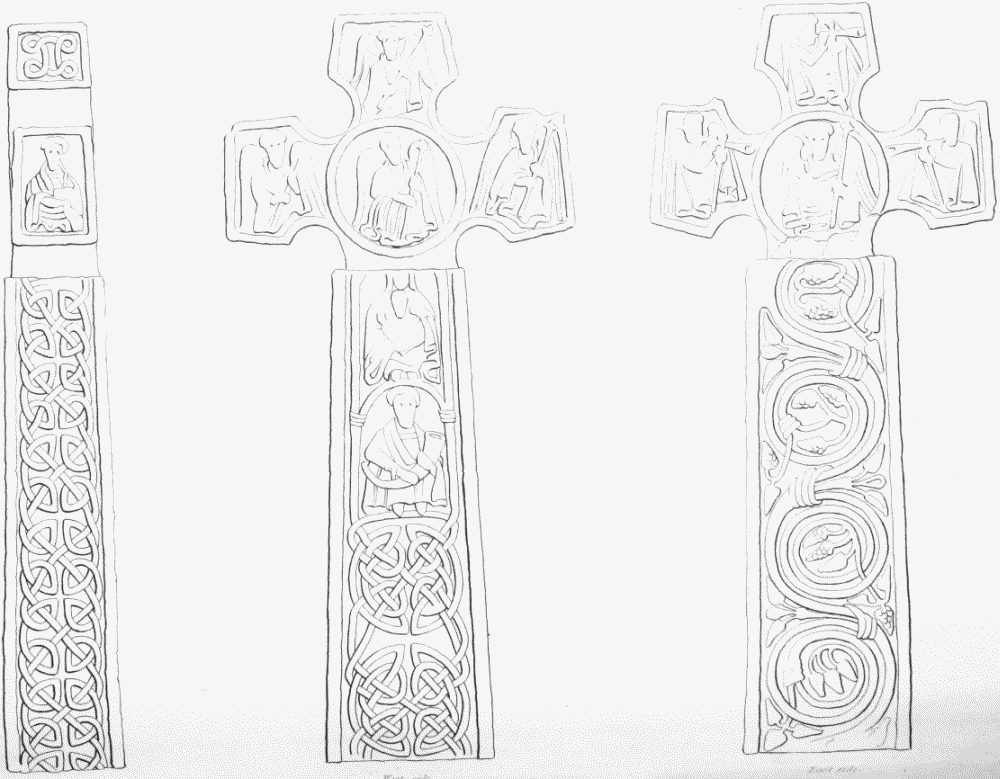
Ancient cross in Eyam church
In Bakewell and Eyam church-yards are ancient stone crosses, ornamented in the style which prevailed in the Saxon times. Bakewell cross is enriched on the east, north, and south sides with elegant scrolls; the west side with rude sculptures in bas-relief, the uppermost of which represents the crucifixion: all of them have suffered much from the effects of time; their present appearance is shewn by the figures in the annexed plate. The cross at Eyam is in the same style; it is at present seven feet in height, but appears to have lost a portion of the upper part, immediately below the cross. The east side of the base is ornamented with an elegant scroll; on this side of the cross part are figures of four angels, in bas-relief, all holding crosses, and two of them blowing trumpets. On the west side are figures rudely sculptured in bas-relief; on the base that of a man in a sitting posture, holding a bugle-horn, and over him what seems to have been designed for the virgin and child; on the lower part are two complicated knots: On the cross part of this side are four figures of angels holding crosses. The north and south sides of the base are ornamented alike with double braids; on the north side of the cross is a half-length figure of a man holding a book, and on the opposite side that of an angel holding a cross.
In Blackwell church-yard is a stone cross, ornamented on every side with braids and knots; and in Bradburn church-yard are several fragments of one,ornamented with scrolls of foliage and rudely sculptured figures, in the style of those of Bakewell and Eyam: one of these fragments is about three feet in length. In Mellor church-yard is the shaft of a cross, of eight unequal sides, and embattled at the top; and at Taddington is one of the same form, the sides of which are ornamented with zig-zag mouldings.